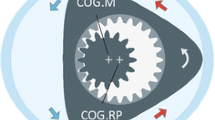Abstract
In roller pumps used for cardiopulmonary bypass (CPB), the degree of blockage within the tube resulting from compression of the tube by the rollers, or the degree of occlusion, is closely related to hemolysis, with both tight occlusive and non-occlusive degrees promoting hemolysis. There are as yet no international standards regarding methods of adjusting occlusiveness, and the amount of mechanical stress exerted upon blood remains unknown. To prevent hemolysis during CPB using roller pumps, there is a need to clarify and quantitatively assess the mechanical stress of the occlusiveness of the roller pump. In this study, we have developed a degree of occlusion quantification system which constructs the flow channel shape within an occluded tube from red optical density images, and we have verified the validity of this system. Utilizing a linear actuator, an acrylic roller and raceway, a solution colored with simulated blood powder, and a 3/8-inch vinyl chloride tube, this system uses a camera to capture red optical density images within an occluded tube and constructs the tube flow channel shape using a formula manipulation system. To verify the accuracy of this system, we compared the thickness of a cross-section of the flow channel constructed with the degree of occlusion quantification system with the thickness of a cross-section of silicone cured under the same occlusion conditions. Our experiments indicated that for areas with a small tube gap, this system can construct highly accurate three-dimensional shapes and obtain quantitative indicators assessing the degree of occlusion.





Similar content being viewed by others
References
Kirklin JK, Westaby S, Blackstone EH, Kirklin JW, Chenoweth DE, Pacifico AD. Complement and the damaging effects of cardiopulmonary bypass. J Thorac Cardiovasc Surg. 1983;86:845–57.
Kameneva MV, Undar A, Antaki JF, Watach MJ, Calhoon JH, Borovetz HS. Decrease in red blood cell deformability caused by hypothermia, hemodilution, and mechanical stress:factors related to cardiopulmonary bypass. ASAIO J. 1999;45:307–10.
Vermeulen Windsant IC, Hanssen SJ, Buurman WA, Jacobs MJ. Cardiovascular surgery and organ damage:time to reconsider the role of hemolysis. J Thorac Cardiovasc Surg. 2011;142:1–11.
Olia SE, Maul TM, Antaki JF, Kameneva MV. Mechanical blood trauma in assisted circulation:sublethal RBC damage preceding hemolysis. Int J Artif Organs. 2016;39:150–9.
Kawahito K, Mohara J, Misawa Y, Fuse K. Platelet damage caused by the centrifugal pump: in vitro evaluation by measuring the release of alpha-granule packing proteins. Artif Organs. 1997;21:1105–9.
Vallely MP, Bannon PG, Bayfield MS, Hughes CF, Kritharides L. Quantitative and temporal differences in coagulation, fibrinolysis and platelet activation after on-pump and off-pump coronary artery bypass surgery. Heart Lung Circ. 2009;18:123–30.
Friedman M, Sellke FW, Wang SY, Weintraub RM, Johnson RG. Parameters of pulmonary injury after total or partial cardiopulmonary bypass. Circulation. 1994;90:262–8.
Ohshiro TU, Mukai K, Kosaki G. Prevention of hemoglobinuria by administration of haptoglobin. Res Exp Med (Berl). 1980;177:1–12.
Parida S, Badhe AS. Cardiac surgery-associated acute kidney injury. J Anesth. 2013;27:433–46.
O'Neal JB, Shaw AD, Billings FT 4th. Acute kidney injury following cardiac surgery: current understanding and future directions. Crit Care. 2016;20:187.
Karkouti K. Transfusion and risk of acute kidney injury in cardiac surgery. Br J Anaesth. 2012;109:i29–38.
Thiele RH, Isbell JM, Rosner MH. AKI associated with cardiac surgery. Clin J Am Soc Nephrol. 2015;10:500–14.
Hobson CE, Yavas S, Segal MS, et al. Acute kidney injury is associated with increased long-term mortality after cardiothoracic surgery. Circulation. 2009;119:2444–533.
Kuitunen A, Vento A, Suojaranta-Ylinen R, Pettilä V. Acute renal failure after cardiac surgery: evaluation of the RIFLE classification. Ann Thorac Surg. 2006;81:542–6.
Kuroiwa T. Clinical studies on extracorporeal circulation considerations on the adequate perfusion based on the perfusion data by nagoya model vi pump-oxygenator. Jpn J Thorac Cardiovasc Surg. 1966;14:1153–94.
Japanese Industrial Standards. T1603 Electric motor driven blood pump for cardiopulmonary bypass. 1995 (In Japanese).
Ghosh S, Falter F, Perrino AC. Cardiopulmonary Bypass. 2nd ed. Cambridge: Cambridge University Press; 2009.
Gravlee GP, Davis RF, Hammon JW. Cardiopulmonary bypass and mechanical support: principles and practice. 4th ed. Philadelphia: Wolters Kluwer Health; 2015.
Hansbro SD, Sharpe DA, Catchpole R, et al. Haemolysis during cardiopulmonary bypass:an in vivo comparison of standard roller pumps, nonocclusive roller pumps and centrifugal pumps. Perfusion. 1999;14:3–10.
Mulholland JW, Shelton JC, Luo XY. Blood flow and damage by the roller pumps during cardiopulmonary bypass. J Fluids Struct. 2005;20:129–40.
Dowson D. Elastohydrodynamic and micro-elastohydrodynamic lubrication. Wear. 1995;190:125–38.
Blackshear PL Jr, Dorman FD, Steinbach JH. Some mechanical effects that influence hemolysis. Trans Am Soc Artif Intern Organs. 1965;11:112–7.
Nevaril CG, Lynch EC, Alfrey CP Jr, Hellums JD. Erythrocyte damage and destruction induced by shearing stress. J Lab Clin Med. 1968;71:784–90.
Leverett LB, Hellums JD, Alfrey CP, Lynch EC. Red blood cell damage by shear stress. Biophys J. 1972;12:257–73.
Bludszuweit C. Model for a general mechanical blood damage prediction. Artif Organs. 1995;19:583–9.
Paul R, Apel J, Klaus S, Schügner F, Schwindke P, Reul H. Shear stress related blood damage in laminar couette flow. Artif Organs. 2003;27:517–29.
Down LA, Papavassiliou DV, O'Rear EA. Significance of extensional stresses to red blood cell lysis in a shearing flow. Ann Biomed Eng. 2011;39:1632–42.
Simmonds MJ, Atac N, Baskurt OK, Meiselman HJ, Yalcin O. Erythrocyte deformability responses to intermittent and continuous subhemolytic shear stress. Biorheology. 2014;51:171–85.
Faghih MM, Sharp MK. Modeling and prediction of flow-induced hemolysis: a review. Biomech Model Mechanobiol. 2019;18:845–81.
Faghih MM, Sharp MK. Evaluation of energy dissipation rate as a predictor of mechanical blood damage. Artif Organs. 2019;43:666–76.
Author information
Authors and Affiliations
Corresponding authors
Ethics declarations
Conflict of interest
The authors declare that they have no conflict of interest.
Additional information
Publisher's Note
Springer Nature remains neutral with regard to jurisdictional claims in published maps and institutional affiliations.
Rights and permissions
About this article
Cite this article
Fukaya, A., Shiraishi, Y., Inoue, Y. et al. Development and accuracy evaluation of a degree of occlusion visualization system for roller pumps used in cardiopulmonary bypass. J Artif Organs 24, 27–35 (2021). https://doi.org/10.1007/s10047-020-01211-x
Received:
Accepted:
Published:
Issue Date:
DOI: https://doi.org/10.1007/s10047-020-01211-x




